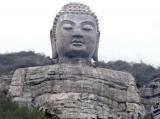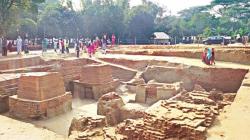INSTITUT SUPERIEUR D'ANTHROPOLOGIE
INSTITUTE OF ANTHROPOLOGY
ONLINE COURSES / COURS A DISTANCE
SPRING TERM : APRIL 2016
REGISTER NOW
NEPAL-  Nigrodharam - Archaeologists have discovered a post hole, believed to be the place where Lord Buddha gave his first sermon while visiting Nepal after attaining enlightenment, during an excavation at Nigrodharam in Kapilvastu district. This was the first time that the post hole had been found in Nigrodharam, after two unsuccessful attempts. Archaeologists involved in the digging claimed that the discovery would be very important for further archaeological studies. They even believed that the finding has deepened the history of the ancient place. Excavations were initiated by digging a trench—26metres long and 1.5metres—between two structures. The trench is about 5metres deep. The post hole, that was discovered in the southern part of the ancient ruins, was six inches in circumference and four inches deep. According to archaeologists, search is on to find other possible post holes in the area. A foreign expert involved said that the post hole has justified that the area belonged to the Buddha era as the wood and bamboo used in the structure were of that time. The finding shows that there was a well-managed settlement in the area. The fresh excavation started in Nigrodharam following the last major digging in 1962. Indian archaeologist Debala Mitra carried out the excavation then and came to a conclusion that the ruins found in the area could date further back than the seventh century. Unesco consultant Basanta Bidari said that the finding has justified that the history of the area is older. He added that the laboratory test of the soil, charcoal and bone would further bring to the fore more historic facts about the place.
Nigrodharam - Archaeologists have discovered a post hole, believed to be the place where Lord Buddha gave his first sermon while visiting Nepal after attaining enlightenment, during an excavation at Nigrodharam in Kapilvastu district. This was the first time that the post hole had been found in Nigrodharam, after two unsuccessful attempts. Archaeologists involved in the digging claimed that the discovery would be very important for further archaeological studies. They even believed that the finding has deepened the history of the ancient place. Excavations were initiated by digging a trench—26metres long and 1.5metres—between two structures. The trench is about 5metres deep. The post hole, that was discovered in the southern part of the ancient ruins, was six inches in circumference and four inches deep. According to archaeologists, search is on to find other possible post holes in the area. A foreign expert involved said that the post hole has justified that the area belonged to the Buddha era as the wood and bamboo used in the structure were of that time. The finding shows that there was a well-managed settlement in the area. The fresh excavation started in Nigrodharam following the last major digging in 1962. Indian archaeologist Debala Mitra carried out the excavation then and came to a conclusion that the ruins found in the area could date further back than the seventh century. Unesco consultant Basanta Bidari said that the finding has justified that the history of the area is older. He added that the laboratory test of the soil, charcoal and bone would further bring to the fore more historic facts about the place.
http://kathmandupost.ekantipur.com/news/2016-01-31/buddha-post-hole-found-in-nigrodharam-area.html
INDE –  Midnapore - Fourteen years after archaeologists stumbled upon the nondescript mound at Moghalmari in West Midnapore district, the site has thrown up one of the largest finds of Buddhist history in India. The site, currently a buzz of activities, has led to the discovery of some 50 relics connected to Buddhism, which was widely practiced in eastern Indian between seventh and 12th Century. On January 23 this year they came across around 40 bronze artifacts dating back to fifth and sixth century. Since then, diggers have come across more relics, with chances that digging deeper will lead to further finds. In 2001, archaeologists first found the structural details of a monastery, an inscribed seal and a broken bust, believed to be of the Buddha. While Moghalmari village, around 180 km from Kolkata, became an important find in understanding history of Buddhism in India, particularly Bengal, the dig emerged a centre of attention since January 23, with archeologists believing the site will provide crucial insights in assessing and understanding spread of Buddhism to eastern India and eventually to other parts of Asia. Archaeologists involved with the project pointed out that the seal found in 2001 carries an inscription in Sanskrit, which when deciphered, turned out to be the Buddhist Dharmaparyay, a hymn with the message of the Buddha’s teachings on philosophy. Besides the seal that dates back to eighth century, archaeologists also found terracotta tablets. The primary image on them is of the Buddha in meditation, with two rows of miniature figures in the bottom, depicting the five famous transcendent Buddhas. Asok Datta from Calcutta University, who led the first excavation team, believes the tablets are a clincher in proving the site’s monastic identity. “The tablets prove the existence of an extensive monastic settlement at the site,” he said.
Midnapore - Fourteen years after archaeologists stumbled upon the nondescript mound at Moghalmari in West Midnapore district, the site has thrown up one of the largest finds of Buddhist history in India. The site, currently a buzz of activities, has led to the discovery of some 50 relics connected to Buddhism, which was widely practiced in eastern Indian between seventh and 12th Century. On January 23 this year they came across around 40 bronze artifacts dating back to fifth and sixth century. Since then, diggers have come across more relics, with chances that digging deeper will lead to further finds. In 2001, archaeologists first found the structural details of a monastery, an inscribed seal and a broken bust, believed to be of the Buddha. While Moghalmari village, around 180 km from Kolkata, became an important find in understanding history of Buddhism in India, particularly Bengal, the dig emerged a centre of attention since January 23, with archeologists believing the site will provide crucial insights in assessing and understanding spread of Buddhism to eastern India and eventually to other parts of Asia. Archaeologists involved with the project pointed out that the seal found in 2001 carries an inscription in Sanskrit, which when deciphered, turned out to be the Buddhist Dharmaparyay, a hymn with the message of the Buddha’s teachings on philosophy. Besides the seal that dates back to eighth century, archaeologists also found terracotta tablets. The primary image on them is of the Buddha in meditation, with two rows of miniature figures in the bottom, depicting the five famous transcendent Buddhas. Asok Datta from Calcutta University, who led the first excavation team, believes the tablets are a clincher in proving the site’s monastic identity. “The tablets prove the existence of an extensive monastic settlement at the site,” he said.
http://www.deccanherald.com/content/526158/trove-buddhist-relics-found-midnapore.html
INDE –  Nateshwar - Sixteen Buddhist stupas, around 1,000-year-old, have recently been unearthed at Nateshwar in the district with a rich archaeological background. The aesthetics of these stupas is unique in architectural style. There are 16 stupas in four inter-connected “Stupa Hall Rooms,” each square-shaped and fenced with brick walls 16 metres in length and 3.5 metres in width.
Nateshwar - Sixteen Buddhist stupas, around 1,000-year-old, have recently been unearthed at Nateshwar in the district with a rich archaeological background. The aesthetics of these stupas is unique in architectural style. There are 16 stupas in four inter-connected “Stupa Hall Rooms,” each square-shaped and fenced with brick walls 16 metres in length and 3.5 metres in width.
http://www.thedailystar.net/backpage/16-buddhist-stupas-found-nateshwar-209926
TURQUIE –  Isaura - Zengibar Castle, located among the remains of ancient Isaura in the Central Anatolian province of Konya, which is considered the Ephesus of the region, will soon open to tourism. The ancient city of Isaura, estimated to have been built in the Byzantine era some 2,000 years ago, is located 16 kilometers away from the Konya city center on an 1860-meter-high hill. The Zengibar Castle in the ancient city surrounded by steep cliffs overlooks Konya and the Taurus mountains. Aksaray University’s archaeology department conducted a surface survey at Isaura in 2010 and the third-degree archaeological site was cleaned in 2013. Following these works, the Konya Metropolitan Municipality made a six-year mid-term plan for the ancient city, while organizations like UNESCO and UNICEF decided to include the ancient site among its places to visit. As part of a long-term plan for the site, the remains of the castle will be collected and a new castle will be constructed.
Isaura - Zengibar Castle, located among the remains of ancient Isaura in the Central Anatolian province of Konya, which is considered the Ephesus of the region, will soon open to tourism. The ancient city of Isaura, estimated to have been built in the Byzantine era some 2,000 years ago, is located 16 kilometers away from the Konya city center on an 1860-meter-high hill. The Zengibar Castle in the ancient city surrounded by steep cliffs overlooks Konya and the Taurus mountains. Aksaray University’s archaeology department conducted a surface survey at Isaura in 2010 and the third-degree archaeological site was cleaned in 2013. Following these works, the Konya Metropolitan Municipality made a six-year mid-term plan for the ancient city, while organizations like UNESCO and UNICEF decided to include the ancient site among its places to visit. As part of a long-term plan for the site, the remains of the castle will be collected and a new castle will be constructed.
http://www.hurriyetdailynews.com/zengibar-castle-to-open-to-tourism.aspx?pageID=238&nID=94515&NewsCatID=375